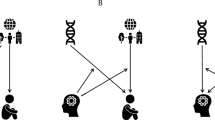Abstract
In order to study the effects of consanguinity on IQ, a survey was conducted among the Ansari Muslims of Bhagalpur residing in suburban and rural areas. Both outbred (N=390 from suburban areas andN=358 from rural areas) and inbred (N's=300 and 266, respectively) children aged 9 to 12 years from socioeconomically middle-class families were administered the Weschler Intelligence Scale for Children—Revised [WISC(R)-74]. The coefficient of inbreeding, F, was .0625. The inbred children showed lower verbal (20 and 22%) and performance (30 and 20%) subtest scores and lower verbal (11 and 11%), performance (17 and 12%), and full-scale (15 and 12%) IQs. A three-factor analysis of variance performed on the full-scale IQ scores indicated that both consanguinity and locality affect IQ. The interaction between these two facors was also significant. Neither age nor sex affected these scores. Overall, subjects' performance scores were lower than verbal scores.
Similar content being viewed by others
References
Afzal, M. (1984).Effects of Consanguinity on Reproductive Fitness and Certain Behavioural Traits of Bihari Muslims, Unpublished Ph.D. thesis, Bhagalpur University, Bhagalpur.
Ansari, N. A., and Sinha, S. P. (1978). Survey on the effects of inbreeding in two populations of Bihar.Indian J. Med. Res. 68:295–299.
Bashi, J. (1977). Effects of inbreeding on cognitive performance.Nature 266:440–442.
Book, J. A. (1957). Genetical investigations in a North Swedish population. The offspring of first cousin marriages.Ann. Hum. Genet.,21:191–221.
Cohen, T., Block, N., Flam, Y., Kadar, M., and Gold-Schmidt, E. (1963). School attainments in an immigrant village. In Gold-Schmidt, E. (ed.),The Genetics of Migrant and Isolate Populations, Williams and Wilkins, New York.
Hunter (1870).A Statistical Account of Bengal, Vol. XIV. Bhagalpur Pargana, Trubner and Coy, London, p. 1877.
Hyden, H. (1967). Behaviour, neural function and RNA.Prog. Nucleic Acids Res. Mol. Biol. 6:187.
Hyden, H., and Lange, P. W. (1970). S-100 brain protein correlation with behaviour.Proc. Natl. Acad. Sci. USA 67:159.
Inbaraj, S. G., and Rao, P. S. S. S. (1978). Mental development among children in relation to parental consanguinity. Preliminary communication presented at the V Annual Conference of the Indian Society of Human Genetics, Bombay, Dec.
Kodama, H., and Shinagawa, F. (1953). WISC Chino-Shidan Kensaho (the WISC intelligence test).Nihon Bunka Kogakusha Tokyo 138.
McNemar, Q. (1942).The Revision of the Stanford-Binet Scale, Houghton Mifflin, Boston.
Muslim India (1983). Cities with over 10% Muslim population in india, Vol. 1, No. 2, Feb.
Neel, J. V., Schull, W. J., Yamamoto, M., Uchida, S., Yanase, T., and Fujiki, N. (1970). The effects of parental consanguinity and inbreeding in Hirado, Japan. II. Physical development, tapping rate, blood pressure, intelligence quotient and school performance.Am. J. Hum. Genet.,22:263–266.
Puri, R. K., Verma, I. C., and Bhargava, I. (1978). Effects of consanguinity in a community in Pondicherry. In Verma, I. C. (ed.),Medical Genetics in India, Vol. 2, Auroma Enterprises. Pondicherry, pp. 129–139.
Rao, P. S. S. S. (1978). Consanguinity and inbreeding in India. Proc. Int. Symp. Pop. Struct. Hum. Var., Bombay, Dec. 19–21.
Roy-Choudhury, P. C. (1962).Bihar District Gazetteers, Bhagalpur: Superintendent, Secretariat Press, Bihar Patna.
Sanghvi, L. D. (1966). Inbreeding in india.Eugen. Q. B:291–301.
Sanghvi, L. D. (1975). Inbreeding in India and its genetic consequences. In Emery, E. H., Reddy, O. S., and Sanjeeva, R. M. (eds.),Proceedings, Seminar on Medical Genetics, Osmania University, Hyderabad, Dec. 1–4, pp. 42–52.
Schull, W. J., and Neel, J. V. (1965)The Effects of Inbreeding on Japanese Children, Harper and Row, New York, p. 419.
Schull, W. J., and Neel, J. V. (1972). The effects of parental consanguinity and inbreeding in Hirado, Japan. V. Summary and interpretation.Am. J. Hum. Genet. 24:425–453.
Shashoua, V. E. (1965). RNA metabolism in goldfish brain during acquisition of new behavioural patterns.Proc. Natl. Acad. Sci. USA 62:160.
Slatis, H. M., and Hoene, R. E. (1961). The effect of consanguinity on the districution of continuously variable characteristics.Am. J. Hum. Genet. 13:28–31.
Terman, L. M., and Merrill, M. A. (1937).Measuring Intelligence, George G. Harrap, London.
Weschler, D. (1974).Weschler Intelligence Scale for Children, Revised Manual. Psychological Corp. New York, p. 191.
Author information
Authors and Affiliations
Additional information
Financial assistance received from the Council of Scientific and Industrial Research [Sanction No. 38(241)/80/EMR-II], New Delhi, is gratefully acknowledged.
Rights and permissions
About this article
Cite this article
Afzal, M. Consequences of consanguinity on cognitive behavior. Behav Genet 18, 583–594 (1988). https://doi.org/10.1007/BF01082310
Received:
Accepted:
Issue Date:
DOI: https://doi.org/10.1007/BF01082310




